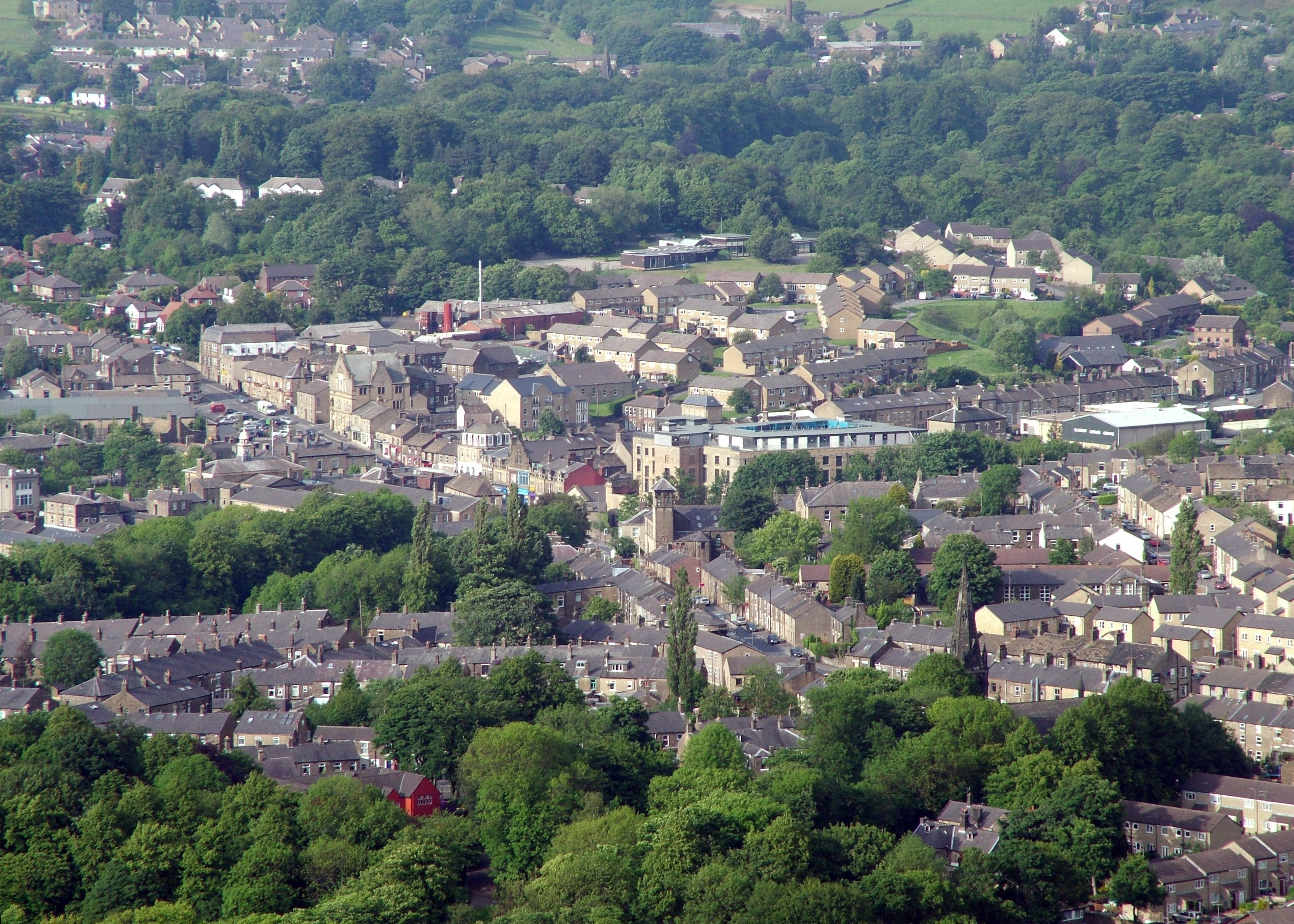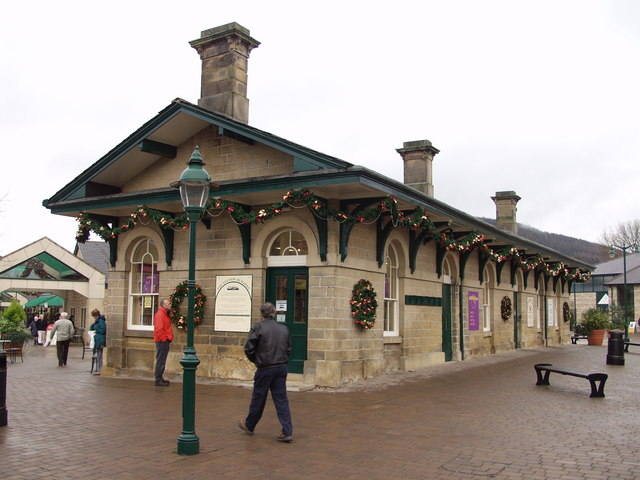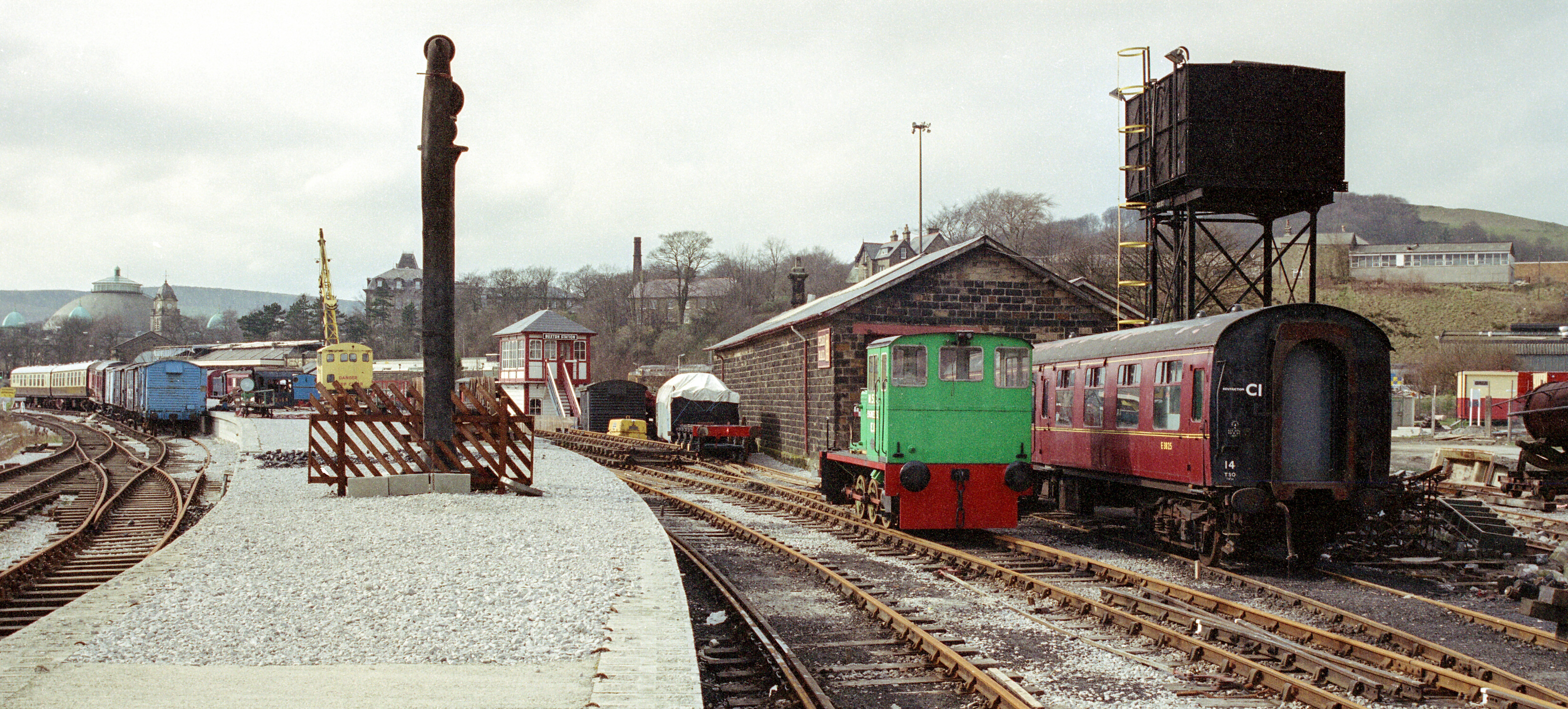|
Peak Forest Railway Station
Peak Forest railway station was opened in 1867 by the Midland Railway on its extension of the Manchester, Buxton, Matlock and Midlands Junction Railway from Rowsley, part of the main Midland Line from Manchester to London. It was also the northern junction for the line from Buxton. It closed in 1967 and the platforms were demolished shortly afterwards. This section of route is still open for stone freight trains serving the Buxton lime industry as the Great Rocks Line. The station building still survives as offices which support the large quarry terminal close by. A short section of one platform has been reinstated for railway staff use. The station is easily visible from the nearby road from Dove Holes. Although it was named Peak Forest it was actually adjacent to the present-day settlement of Peak Dale. It marked the summit of the line before it dropped through Dove Holes Tunnel Dove Holes Tunnel is a tunnel built by the Midland Railway between Peak Forest Signal Box and ... [...More Info...] [...Related Items...] OR: [Wikipedia] [Google] [Baidu] |
High Peak (borough)
High Peak is a local government district with borough status in Derbyshire, England. The borough compromises high moorland plateau in the Dark Peak area of the Peak District National Park. The district stretches from Holme Moss in the north to Sterndale Moor in the south, and from Hague Bar in the west to Bamford in the east. The population of the borough taken at the 2011 Census was 90,892. The borough is unusual in having two administrative centres for its council, High Peak Borough Council; the offices are based in both Buxton and Glossop. The borough also contains other towns including Chapel-en-le-Frith, Hadfield, New Mills and Whaley Bridge. High Peak was the name of a hundred of the ancient county of Derbyshire covering roughly the same area as the current district. It may have derived its name from the ancient Forest of High Peak, a royal hunting reserve administered by William Peverel, a favourite of William I, who was based at Peak Castle. High Peak contains muc ... [...More Info...] [...Related Items...] OR: [Wikipedia] [Google] [Baidu] |
Midland Railway
The Midland Railway (MR) was a railway company in the United Kingdom from 1844. The Midland was one of the largest railway companies in Britain in the early 20th century, and the largest employer in Derby, where it had its headquarters. It amalgamated with several other railways to create the London, Midland and Scottish Railway at grouping in 1922. The Midland had a large network of lines emanating from Derby, stretching to London St Pancras, Manchester, Carlisle, Birmingham, and the South West. It expanded as much through acquisitions as by building its own lines. It also operated ships from Heysham in Lancashire to Douglas and Belfast. A large amount of the Midland's infrastructure remains in use and visible, such as the Midland main line and the Settle–Carlisle line, and some of its railway hotels still bear the name '' Midland Hotel''. History Origins The Midland Railway originated from 1832 in Leicestershire / Nottinghamshire, with the purpose of serving the needs o ... [...More Info...] [...Related Items...] OR: [Wikipedia] [Google] [Baidu] |
London, Midland And Scottish Railway
The London, Midland and Scottish Railway (LMSIt has been argued that the initials LMSR should be used to be consistent with LNER, GWR and SR. The London, Midland and Scottish Railway's corporate image used LMS, and this is what is generally used in historical circles. The LMS occasionally also used the initials LM&SR. For consistency, this article uses the initials LMS.) was a British railway company. It was formed on 1 January 1923 under the Railways Act of 1921, which required the grouping of over 120 separate railways into four. The companies merged into the LMS included the London and North Western Railway, Midland Railway, the Lancashire and Yorkshire Railway (which had previously merged with the London and North Western Railway on 1 January 1922), several Scottish railway companies (including the Caledonian Railway), and numerous other, smaller ventures. Besides being the world's largest transport organisation, the company was also the largest commercial enterprise ... [...More Info...] [...Related Items...] OR: [Wikipedia] [Google] [Baidu] |
Manchester, Buxton, Matlock And Midlands Junction Railway
The Manchester, Buxton, Matlock and Midland Junction Railway ran from a junction with the Midland Railway at Ambergate to Rowsley north of Matlock and thence to Buxton. In time it would become part of the Midland Railway's main line between London and Manchester, but it was initially planned as a route from Manchester to the East of England, via the proposed Ambergate, Nottingham, Boston and Eastern Junction Railway which would meet it a little further north along the North Midland line at Ambergate. The Act for a line from just south of Stockport to Ambergate was passed in 1846. Currently, the section north of Millers Dale is open as the Great Rocks freight line, Derby to Matlock still holds passenger services as the Derwent Valley line, Matlock to Rowsley is the Peak Rail heritage line, and Rowsley to Buxton has become the Monsal Trail for cycling, horse riding and walking. Ambergate to Rowsley The initial plan was for "An Act for making a Railway from the Manchester an ... [...More Info...] [...Related Items...] OR: [Wikipedia] [Google] [Baidu] |
Rowsley
Rowsley () is a village on the A6 road in the English county of Derbyshire. The population as at the 2011 census was 507. It is at the point where the River Wye flows into the River Derwent and prospered from mills on both. The border of the Peak District National Park runs through the village west of the River Wye and immediately to the north of Chatsworth Road. The Peak District Boundary Walk goes through the village. Overview Notable features are the bridge over the River Derwent, St Katherine's Church, Rowsley and the Grade-II*-listed Peacock hotel, originally built in 1652 as a manor house by John Stevenson, agent to Lady Manners, whose family crest bearing a peacock gives it its name. Both Longfellow and Landseer are said to have stayed there. Nearby is Chatsworth House, home of the Duke and Duchess of Devonshire. It was the site of an extensive motive power depot and marshalling yard, the first being built by the Manchester, Buxton, Matlock and Midlands Junction Rail ... [...More Info...] [...Related Items...] OR: [Wikipedia] [Google] [Baidu] |
Buxton Lime Industry
The Buxton lime industry has been important for the development of the town of Buxton in Derbyshire, England, and it has shaped the landscape around the town. Geology The White Peak area of the Peak District is named after the limestone plateau landscape of the 'Derbyshire Dome'. This limestone outcrop is surrounded by a horseshoe-shaped formation of younger sandstones ( gritstones) and shales. Buxton is at the western edge of the limestone region. The layers of carboniferous limestone were deposited in a warm shallow sea in the Brigantian stage of the Carboniferous period (around 330 million years ago). These deposits were compressed into rocks which over time were uplifted and folded into a dome. Erosion of the younger sandstones exposed the limestone strata. The limestone in the Bee Low and Woo Dale limestone formations around Buxton is of unusually high quality, with less than 3% dolomite and less than 1% chert. History Limestone has been quarried as building stone in ... [...More Info...] [...Related Items...] OR: [Wikipedia] [Google] [Baidu] |
Great Rocks Line
The Great Rocks Line is a freight railway line in Derbyshire, England, that runs between the Hope Valley Line at Chapel Milton and the stone quarries and sidings at Peak Dale and Peak Forest, before looping around to the town of Buxton. It takes its name from the Great Rocks Dale through which it runs. It was opened in 1867 as an extension to the Manchester, Buxton, Matlock and Midland Junction Railway, allowing the passenger trains of the Midland Railway a connection the whole way from London to Manchester for the first time. However, the rest of the former MBM&MJR was closed in June 1968 by the Labour Minister for Transport, Barbara Castle, leaving the northern section now known as the Great Rocks Line open only for stone freight trains and as an emergency diversionary route for the passenger Buxton line. The most notable structure on the line is the bifurcated Chapel Milton Viaduct, just below the junction with the main line between Sheffield and Manchester. It also passes thr ... [...More Info...] [...Related Items...] OR: [Wikipedia] [Google] [Baidu] |
Peak Dale
Peak Dale is a small village in Derbyshire, England, northeast of Buxton and southeast of Dove Holes. The population falls within the civil parish of Wormhill. The village is between Dove Holes Quarry (to the north) and Tunstead Quarry (to the south), with other smaller quarries in the vicinity. It was built to house quarry workers and their families, but some of the original houses have now been demolished. The village has a club (Great Rocks Club), a playground and a primary school. Great Rocks Dale lies immediately south of the village. Railway The village previously had a railway station called Peak Forest railway station, on the Midland Railway The Midland Railway (MR) was a railway company in the United Kingdom from 1844. The Midland was one of the largest railway companies in Britain in the early 20th century, and the largest employer in Derby, where it had its headquarters. It am ... line, which closed when passenger services were withdrawn. However, the station ... [...More Info...] [...Related Items...] OR: [Wikipedia] [Google] [Baidu] |
Dove Holes Tunnel
Dove Holes Tunnel is a tunnel built by the Midland Railway between Peak Forest Signal Box and Chapel-en-le-Frith in Derbyshire in 1860–64, now carrying the Great Rocks Line. In the mid-nineteenth century, the Manchester, Buxton, Matlock and Midlands Junction Railway was jointly leased by the LNWR and Midland Railway, and ran as far as Rowsley. The Midland wished to extend to Manchester to give it a service to London but the LNWR, having its own London line, declined. It then supported the Stockport, Disley and Whaley Bridge Railway in building a line from Whaley Bridge to Buxton, one which the Midland considered unsuitable as a main line, due to its steep gradients over Cow Low. In the end, however, the Midland came to an agreement with the Manchester, Sheffield and Lincolnshire Railway that was formalised as the Sheffield and Midland Railway Companies' Committee. The Midland would extend its line to New Mills to meet a line the MS&LR was building from its main line out of M ... [...More Info...] [...Related Items...] OR: [Wikipedia] [Google] [Baidu] |
Chapel-en-le-Frith Central Railway Station
Chapel-en-le-Frith Central railway station was an intermediate stop on the Derby–Manchester line of the Midland Railway. It served the Derbyshire town of Chapel-en-le-Frith between 1867 and 1967. History The station was opened by the Midland Railway (MR) on 1 February 1867. At the start of 1923, the MR amalgamated with several other railways to form the London, Midland and Scottish Railway (LMS), which inherited two stations at Chapel-en-le-Frith; to distinguish the ex-MR station from the ex-London and North Western Railway station, the former was renamed ''Chapel-en-le-Frith Central'' on 2 June 1924. The station was closed on 6 March 1967. This section of route is still open for stone freight trains serving the Buxton lime industry as the Great Rocks Line The Great Rocks Line is a freight railway line in Derbyshire, England, that runs between the Hope Valley Line at Chapel Milton and the stone quarries and sidings at Peak Dale and Peak Forest, before looping around to t ... [...More Info...] [...Related Items...] OR: [Wikipedia] [Google] [Baidu] |
Buxton (Midland) Railway Station
Buxton (Midland) railway station served the town of Buxton, Derbyshire, England between 1863 and 1967. History The station was opened by the Midland Railway (MR) on 1 June 1863. It was adjacent to, and to the south-east of, the Buxton railway station of the Stockport, Disley and Whaley Bridge Railway, which opened two weeks later. The two stations had similar end walls incorporating a large fan-shaped window. The station was the terminus of the MR route from Derby. This route had opened as far as on 4 June 1849; and was continued to Buxton in 1863. The station was from . The station closed on 6 March 1967. Most of the station was subsequently demolished and the land used for a ring road. Part of the site including the trackbed of the tracks outside the station were occupied by the Buxton Steam Centre of the Peak Rail Peak Rail is a preserved railway in Derbyshire, England, which operates a steam and heritage diesel service for tourists and visitors to both the Peak Di ... [...More Info...] [...Related Items...] OR: [Wikipedia] [Google] [Baidu] |
Former Midland Railway Stations
A former is an object, such as a template, gauge or cutting die, which is used to form something such as a boat's hull. Typically, a former gives shape to a structure that may have complex curvature. A former may become an integral part of the finished structure, as in an aircraft fuselage, or it may be removable, being using in the construction process and then discarded or re-used. Aircraft formers Formers are used in the construction of aircraft fuselage, of which a typical fuselage has a series from the nose to the empennage, typically perpendicular to the longitudinal axis of the aircraft. The primary purpose of formers is to establish the shape of the fuselage and reduce the column length of stringers to prevent instability. Formers are typically attached to longerons, which support the skin of the aircraft. The "former-and-longeron" technique (also called stations and stringers) was adopted from boat construction, and was typical of light aircraft built until the ad ... [...More Info...] [...Related Items...] OR: [Wikipedia] [Google] [Baidu] |









